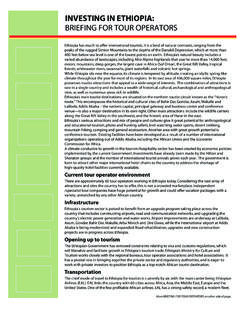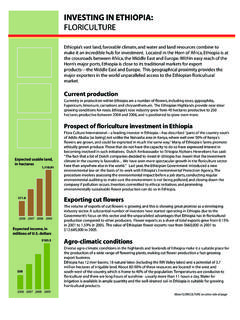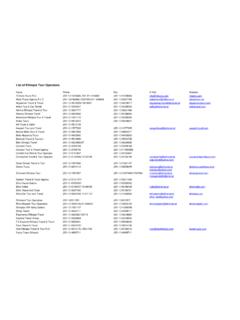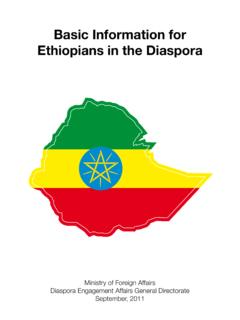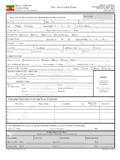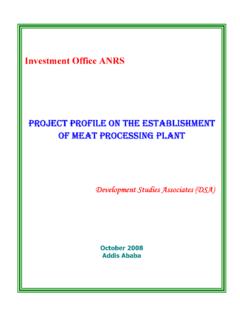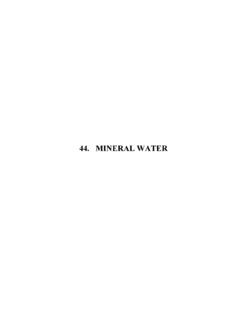Transcription of INVESTING IN ETHIOPIA: AGRICULTURE - …
1 INVESTING IN ethiopia : AGRICULTURE . ethiopia 's economy is chiefly agricultural, with more than 80% of the country's population employed in this sector. The size of ethiopia 's livestock resources is the largest in Africa and the tenth largest in the world. While the contribution of the livestock industry to the country's total exports is currently low compared to its potential, this sector holds great promise as a source of export diversification for the future. Other parts of this sector with substantial opportunities for new investment include: plantation crops (such as tea, coffee and tobacco); production and processing of oil crops and cotton; fish farming; horticulture and floriculture (fruits, vegetables and flowers); livestock and poultry; and forestry and forest by-products. Although ethiopia lies within the tropics, temperatures range from a mean annual high of 86 degrees Fahrenheit to a mean annual low of 50 degrees Fahrenheit. The liberalization of AGRICULTURE Since the new Ethiopian Government made AGRICULTURE its primary priority in 1991, ethiopia has developed and implemented its Agricultural Development Led-Industrialization (ADLI) strategy.
2 The key concept underlying ADLI is an export-led development strategy aimed at promoting economic growth in ethiopia while coordinating agricultural and industrial development. Export growth has benefited from the economic liberalization process underway in ethiopia and the Government's strong commitment to creating a supportive environment for the development of the private sector. Recognizing that large capital investments are needed to exploit ethiopia 's resources, various incentives are being provided to encourage foreign investment (including joint ventures and marketing arrangements) so that the agricultural sector makes a significant contribution to ethiopia 's development. The program, which covers all regions in ethiopia , has become an integral part of the country's agricultural activities. AGRICULTURE and agro-processing Major Ethiopian export products include: coffee, livestock products (skins and hides, leather, live animals and meat), oil seeds and pulses, fruits, vegetables and flowers, textiles, natural gum, spices and mineral products.
3 In addition to the current efforts underway to increase the supply and improve the quality of these export products, ethiopia is highly encouraging investments in other currently unexploited, higher value-added export sectors. ethiopia has tremendous potential for investment in agroprocessing. Many of its agricultural products can be exported without being processed, while others can be processed before they are brought to domestic and foreign markets. While the government encourages the export of unprocessed agricultural products, it has placed a priority on the export of processed products, which involves and stimulates the growth of the agro-processing sector. Through the development of agro-processing, ethiopia 's agricultural sector can achieve swift and sustained long-term economic development. Key agricultural sectors Coffee The word "coffee" comes from the name Kaffa one of the many parts of ethiopia where coffee is grown. ethiopia is the largest producer of coffee in Africa, with a reputation for producing some of the world's finest coffees.
4 More than 60% of Ethiopian coffee is produced as forest or semi-forest coffee. The soil of the forest floor is enriched from falling leaves, making fertilizers unnecessary. In these forests, the high genetic diversity has created a balance between pests and parasites, also rendering chemical pesticides unnecessary. Approximately 65% of Ethiopian coffee exports are naturally dried, while 35% are pulped and washed . Coffee grows at an elevation between 3,600 and 7,500 feet above sea level. The three main regions from which Ethiopian coffee beans originate are Harrar, Ghimbi and Sidamo (Yirgacheffe). More AGRICULTURE on other side of page. INVESTING IN ethiopia : AGRICULTURE . Continued from other side of page Livestock ethiopia is the world's tenth largest livestock producer and the biggest exporter of livestock in Africa. The country has 40 million cattle, million sheep, million goats and million camels, according to a sample census carried out by the Central Statistics Authority of ethiopia between 2001.
5 And 2003. ethiopia presently offers the global market a wide range of processed and semi-processed hides and skins. Some of the products, such as Ethiopian highland sheepskin, are renowned for their quality and natural characteristics. The export of finished leather and leather products (such as leather garments, footwear, gloves, bags and other leather articles) is also increasing. Oilseeds and pulses Ethiopian oilseeds and pulses are mostly organically produced, and are known for their flavor and nutritional value. The Ethiopian white sesame seed is used as a reference for grading in international markets. ethiopia 's major oilseeds and pulses exports include the following: sesame seeds, Niger seeds, linseeds, sunflower seeds, groundnuts, rape seeds, castor oil seeds, pumpkin seeds, haricot beans, pea-beans, horse beans, chick peas, beans and lentils. The European Union, Asia, the Gulf States and neighboring African countries comprise the major markets for ethiopia 's oilseeds and pulses exports.
6 Natural gum ethiopia 's unique climatic conditions enable it to grow diverse plant species used for industrial and pharmaceutical purposes. Acacia, Commiphora and Boswellia are just one group of the various plant species grown in the arid and semi-arid areas which produce gums. The production of gum and its use have grown in recent years due to the increasing trend of convenient food consumption. As in most other sectors of the additives industry, increasing health consciousness on the part of consumers has also fueled growth for thickeners of natural origin. Textile fabrics and garments State-owned and private textile and garment factories make textiles the largest manufacturing industry in ethiopia . The industry employs about 30,000 workers and has a share of 36% of the entire manufacturing industry. An industry-specific institute slated to become a separate Department for Textile Engineering was set up at Bahir Dar University as a result of a Government initiative to promote quality products.
7 The main textile products manufactured in ethiopia are cotton and nylon fabrics, acrylic yarn, woolen and waste cotton blankets and sewing thread. The domestic potential of cotton production as a basic raw material is far more than the current installed spinning capacity demands. The availability of cheap labor is a major factor for making the industrial sector one of the strategic industries for export development. Tea Climatic conditions, the type of soil and the method of processing combine to produce quality Ethiopian teas. In ethiopia , tea is mostly grown in the dense forest highlands where the land is fertile and the use of fertilizer is very low. Manual weeding is employed thanks to the availability of abundant and cheap labor. Ethiopian tea is highly sought after thanks to its mostly organic cultivation. The International Gold Star award for quality was recently given by in Madrid, Spain, to Tea Production and Marketing Enterprise one of the major Ethiopian tea exporters.
8 Fruits, vegetables and flowers Most regions of ethiopia are suitable for the production of a wide range of tropical and sub-tropical Embassy of ethiopia fruits, vegetables and flowers, thanks to the country's favorable climate, abundant labor, and land and Economy and Business Section water resources. Major vegetable export products include: lettuce, potatoes, green beans, okra, melons, 3506 International Drive white and red onions, shallots, cabbages, leeks, beetroots, carrots, green chillies and tomatoes. Among Washington, 20008. Tel-202-364-6385. the main exportable fruits are oranges, mandarin grapefruits, mangos, guavas, lemons and limes. Cut Fax-202-587-0195 flower and vegetable production are fast growing export businesses, and ethiopia is a center of diversity for a variety of flowering plants. The volume of export of these products is growing and showing great promise. Main cut flower exports include: statice, alliums, roses and carnations.

